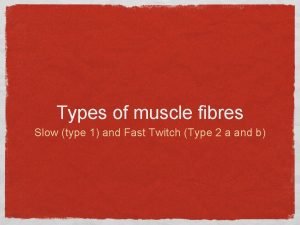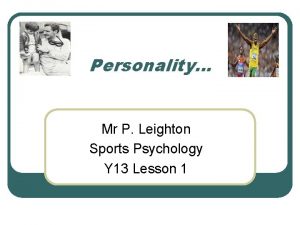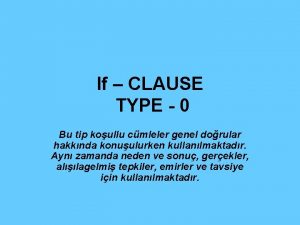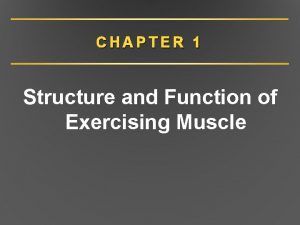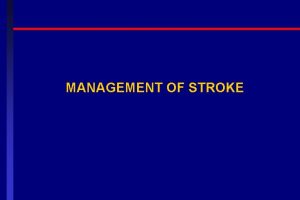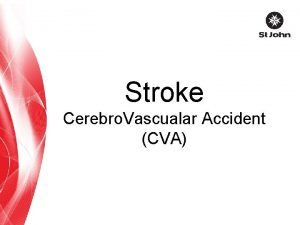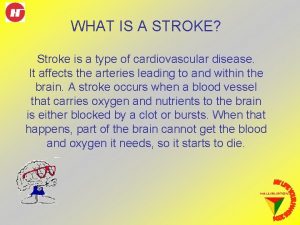WHAT IS A STROKE Stroke is a type










- Slides: 10

WHAT IS A STROKE? Stroke is a type of cardiovascular disease. It affects the arteries leading to and within the brain. A stroke occurs when a blood vessel that carries oxygen and nutrients to the brain is either blocked by a clot or bursts. When that happens, part of the brain cannot get the blood and oxygen it needs, so it starts to die.

TYPES OF STROKE Ischemic stroke is caused by a lack of blood reaching part of the brain and is the most common type, accounting for over 80 percent of all strokes: • Symptoms develop over a few minutes or worsen over hours. • Ischemic strokes are typically preceded by symptoms or warning signs that may include loss of strength or sensation on one side of the body, problems with speech and language or changes in vision or balance. • Ischemic strokes usually occur at night or first thing in the morning. • Often a TIA (transient ischemic attack) or “mini stroke” may give some warning of a major ischemic stroke.

TYPES OF STROKE Fifteen to 20 percent of strokes happen when a blood vessel ruptures in or near the brain. This is called a hemorrhagic or bleeding stroke: • In hemorrhagic strokes, the fatality rate is higher and overall prognosis is poorer. • People who have hemorrhagic strokes are younger. • This kind of stroke is often associated with a very severe headache, nausea and vomiting, and usually the symptoms appear suddenly. • A transcient ischemic attack (TIA) or any other stroke warning sign may not precede this type of stroke.

RISK FACTORS FOR STROKE What are the risk factors I can’t control? Increasing age – stroke affects people of all ages, from young children to elderly individuals. But the older you are, the greater your stroke risk. Gender – in most age groups, more men than women have stroke, but more women die from stroke. Heredity and race – people whose close blood relations have had a stroke have a higher risk of stroke themselves. Certain races have a higher risk of death and disability from stroke than others, because they have high blood pressure more often. Prior stroke – someone who has had a stroke is at a higher risk of having another one.

RISK FACTORS FOR STROKE Knowing your risk factors is the key to prevention - some can be changed or treated, others can’t. What risk factors can I change or treat? High blood pressure – this is the single most important risk factor for stroke. Know your blood pressure and have it checked at least once every two years. If it’s 140/90 or about, it’s high. Talk to your doctor about how to control it and take your medicine as directed; Diet - improve your eating habits by avoiding foods which are high in fat and cholesterol, cut down on saturated fat, sugar and salt. Eat more fruit, vegetables, cereals, dried peas and beans, pasta, fish, poultry and lean meats; Tobacco use – don’t smoke cigarettes or use other forms of tobacco; Diabetes – while diabetes is treatable, having it increases your risk of stroke. Work with your doctor to manage diabetes and reduce other risk factors;

RISK FACTORS FOR STROKE Carotid or other artery disease – the carotid arteries in your neck supply blood to your brain. A carotid artery damaged by a fatty build-up of plaque inside the artery wall may become blocked by a blood clot, causing a stroke; TIAs – Transient ischemic attacks (TIAs) are “mini strokes” that produce strokelike symptoms but no lasting effects. Recognizing and treating TIAs can reduce the risk of a major stroke. Know the warning signs of a TIA and seek emergency medical treatment immediately; Atrial fibrillation or other heart disease – in atrial fibrillation the heart’s upper chambers quiver rather than beat effectively, causing the blood to pool and clot, increasing the risk of stroke. People with other types of heart disease have a higher risk of stroke too; Certain blood disorders – a high red blood cell count makes clots more likely, raising the risk of stroke. Sickle cell anemia increases stroke risk because the “sickled” cells stick to blood vessel walls and may block arteries; High blood cholesterol – high blood cholesterol increases the risk of clogged arteries. If an artery leading to the brain becomes blocked, a stroke results.

RISK FACTORS FOR STROKE Physical inactivity and obesity - being inactive, obese or both can increase your risk of cardiovascular disease. Exercise regularly – check with your doctor before you start. Start slowly and build up to at least 30 minutes a session at least three to four times per week. Try to maintain a healthy weight; Excessive alcohol intake – drinking an average of more than one drink per day for women or more than two drinks a day for men raises blood pressure. Binge drinking can lead to stroke, so limit your alcohol intake. Stress – decrease your stress level as much as possible and seek emotional support when it’s needed.

HOW TO RECOGNIZE IF YOU ARE HAVING A STROKE. . . Call the Emergency Services immediately if you are experiencing: • Sudden numbness or weakness of the face, arm or leg, especially on one side of the body; • Sudden confusion, trouble speaking or understanding; • Sudden trouble seeing in one or both eyes; • Sudden trouble walking, dizziness, loss of balance or co-ordination; • Sudden severe headache with no known cause.

HOW TO RECOGNIZE IF SOMEONE ELSE IS HAVING A STROKE. . . At a recent American Stroke Association conference, a report was presented that showed a bystander may be able to spot someone having a stroke by giving a quick, simple test, as follows: • Asking the individual to smile; • Asking him or her to raise both arms and keep them up; • Asking the person to speak a simple sentence coherently. If the person has trouble with any of these tasks, contact the Emergency Services immediately and describe the symptoms to the Dispatcher. Time is crucial in treating a stroke.

Southern Gulf PII Health & Safety Team
 Anterior stroke vs posterior stroke
Anterior stroke vs posterior stroke What is the primary function of wave summation
What is the primary function of wave summation Name type compatibility and structure type compatibility
Name type compatibility and structure type compatibility Type checking and type conversion in compiler design
Type checking and type conversion in compiler design Type type revolution
Type type revolution Mr. p
Mr. p Blood type and body type
Blood type and body type ıf clauses type 1 exercises
ıf clauses type 1 exercises Type 1 error and type 2 error in statistics
Type 1 error and type 2 error in statistics M type tubes
M type tubes Type 1 vs type 2 fibers
Type 1 vs type 2 fibers

